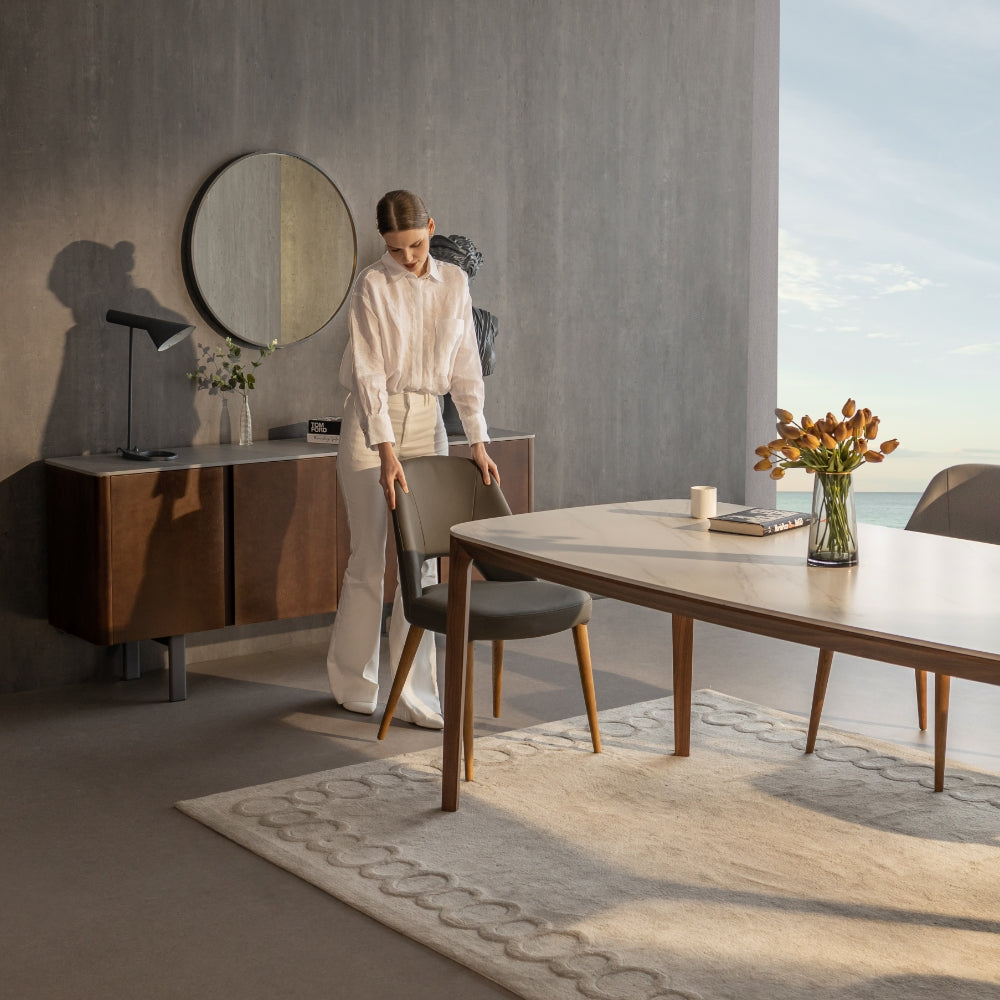When it comes to choosing a dining table materials, the ceramic vs. marble dilemma often arises. Both materials offer unique characteristics and can enhance the aesthetics of your dining space. In this article, we will explore the features and differences between ceramic and marble dining tables, highlight the differences between them, and help you make an informed choice for your dining room table.
Features of Ceramic Dining Tables
Ceramic dining tables are known for their durability and versatility. Ceramic is a highly durable material that resists scratches, stains, and heat. It is available in a variety of colors and finishes, allowing you to find the perfect match for your dining room decor.
Ceramic tables are also relatively lightweight, making them easier to move or rearrange when needed. Additionally, ceramic is a non-porous material, which means it is resistant to liquid absorption and easy to clean.
Ceramic tables offer a wide range of design options, allowing you to choose from different shapes, sizes, and styles. Whether you prefer a sleek and modern look or a more traditional and rustic feel, there is a ceramic dining table to suit your taste. The versatility of ceramic tables makes them suitable for various interior design styles and allows for easy coordination with other furniture pieces in your dining room.
One of the benefits of ceramic dining tables is their durability. Ceramic is a strong and resilient material that can withstand everyday use and the demands of a busy dining area.

Ceramic dining tables are very strong and and resistant to scratches
It is resistant to scratches, which makes it an excellent choice for households with children or pets. You can place dishes, cutlery, and other dining essentials directly on the ceramic surface without worrying about leaving permanent marks or damage.
Features of Marble Dining Tables
Marble dining tables exude elegance and sophistication. Marble is a natural stone that adds a touch of luxury to any dining room. With its unique veining patterns and color variations, each marble table becomes a one-of-a-kind piece. The natural beauty of marble creates a visually stunning focal point in the dining area and can elevate the overall aesthetic of the space.
Marble tables are highly regarded for their heat resistance, which makes them ideal for serving hot dishes directly on the table. You don't have to worry about using trivets or coasters to protect the surface from heat damage. This feature adds to the convenience and functionality of marble dining tables, especially during gatherings or special occasions when serving hot meals is common.
However, it's worth noting that marble is a porous material. This means that it has small pores and can absorb liquids and stains if not properly sealed. Regular maintenance is required to keep a marble table in its best condition. It is recommended to seal the marble surface periodically to prevent liquid penetration and minimize the risk of stains. Spills should be cleaned up promptly to avoid potential damage to the stone.
Differences Between Ceramic and Marble Dining Tables
Let’s look at a brief comparison the difference between Ceramic and Marble in the below table before we deep dive into the details:
|
Feature |
Ceramic Dining Tables |
Marble Dining Tables |
|
Material |
Mixture of clay, minerals, and water |
Natural stone (Marble) |
|
Aesthetic Appeal |
Versatile and modern |
Elegant and timeless |
|
Design Options |
Wide range of designs, colors, and patterns |
Limited color options, but unique natural patterns |
|
Durability |
Resistant to scratches, stains, and heat |
Highly durable, but prone to scratching and staining |
|
Weight |
Relatively lightweight |
Heavyweight |
|
Maintenance |
Relatively easy to clean and maintain |
Requires regular maintenance to prevent staining and scratching |
|
Price |
Generally more affordable |
Usually more expensive |
3.1. Differences in Appearance and Aesthetics
Ceramic tables offer a wide range of colors, patterns, and finishes, allowing you to choose a style that complements your dining room decor. From vibrant and bold hues to subtle and neutral tones, ceramic tables provide options for various design preferences. You can select a ceramic dining table that seamlessly integrates into your existing interior design or serves as a statement piece that adds visual interest to the space.
Marble tables, on the other hand, have a timeless beauty with their natural veining and unique patterns. The veining in marble is a result of various mineral impurities present in the stone, creating intricate and eye-catching designs. The natural variation in colors and patterns makes each marble table truly unique. Marble tables often evoke a sense of elegance and luxury, and they can become the centerpiece of your dining room.
3.2. Cleaning and Maintenance Considerations
Ceramic tables are relatively low-maintenance and easy to clean. The non-porous surface of ceramic resists liquid absorption, making it less prone to stains. Regular cleaning with a mild detergent and a soft cloth is usually sufficient to keep a ceramic table looking its best. However, it is still advisable to avoid abrasive cleaners or scrubbing tools that could potentially scratch the surface.
Marble tables require more attention when it comes to cleaning and maintenance. As a porous material, marble is susceptible to staining if spills are not promptly cleaned. It is recommended to wipe up spills immediately and use a mild, pH-neutral cleaner specifically designed for marble surfaces. Sealing the marble periodically helps protect the stone and maintain its appearance.
3.3. Heat Resistance and Stain Resistance
Ceramic tables are known for their excellent heat resistance. You can place hot dishes or cookware directly on the ceramic surface without worrying about heat damage. This feature adds to the convenience and functionality of ceramic dining tables, allowing you to serve meals without the need for additional trivets or coasters.
Marble tables also have good heat resistance, making them suitable for serving hot dishes. However, it is still recommended to use trivets or heat-resistant pads as an extra precaution to protect the marble surface from extreme temperatures.

Both Ceramic and Marble materials have good heat resistance
In terms of stain resistance, ceramic tables have an advantage due to their non-porous nature. The non-absorbent surface makes it easier to clean up spills and prevents stains from penetrating the material. Marble, being a porous material, is more prone to staining. Promptly cleaning spills and applying a sealant can help minimize the risk of permanent stains on the marble surface.
3.4. Weight
Ceramic tables are generally lighter in weight compared to marble tables. This makes it easier to move or rearrange if you need to change the layout of your dining room or relocate the table to a different area. The lighter weight of ceramic tables can be a practical advantage, especially if you anticipate the need for frequent table adjustments.
Marble tables, on the other hand, tend to be heavier due to the density and weight of the stone. Once a marble table is in place, it provides stability and a substantial feel. The weight of a marble table contributes to its durability and sturdiness, creating a sense of permanence in your dining room.
3.5. Design Considerations
When considering the design of your dining room table, both ceramic and marble offer a wide range of options to suit different styles. Ceramic tables come in various shapes, including rectangular, round, square, and oval, allowing you to choose the shape that best fits your dining space. They also offer different leg styles, such as straight legs, tapered legs, or pedestal bases, providing versatility in design.
Marble tables are often associated with a classic and timeless aesthetic. They typically have a solid slab of marble as the tabletop, which creates a seamless and luxurious look. The natural veining and patterns in marble add visual interest and can become a conversation piece in your dining room. Marble tables are available in different shapes and sizes, allowing you to select the one that fits your space and design vision.
3.6. Cost and Budget Considerations
The cost of a dining table can vary depending on various factors, including the material, size, design, and brand. Generally, ceramic tables tend to be more affordable compared to marble tables. Ceramic is a man-made material that is easier to produce and comes in a range of price points to suit different budgets. This makes ceramic tables a popular choice for those looking for a cost-effective yet stylish dining option.
Marble tables, on the other hand, are often considered a luxury dining table choice and tend to be more expensive. The natural beauty and elegance of marble come with a higher price tag due to the quality and rarity of the stone. If you are willing to invest in a timeless and sophisticated dining table, a marble option might be worth considering.
Ceramic vs. Marble: Which Is The Best Choice For a Dining Room Table?
Now that we have explored the features and differences between ceramic and marble dining tables, you may be wondering which one is the best choice for your dining room. It ultimately depends on your personal preferences, lifestyle, and budget.
If you prioritize durability, ease of maintenance, and a wide range of design options, a ceramic dining table may be the ideal choice for you. Ceramic tables offer benefits such as scratch resistance, heat resistance, and easy cleaning. They are available in various colors and finishes, allowing you to find a style that matches your dining room decor. Additionally, ceramic tables are often more budget-friendly compared to marble options.
However, if you desire a luxurious and timeless centerpiece for your dining room and are willing to invest in a high-end option, a marble dining table can add a touch of elegance and sophistication. Marble tables are known for their natural beauty, unique veining patterns, and heat resistance. They can elevate the aesthetic of your dining space and create a lasting impression.
At Cozy Living, we specialize in ceramic dining tables that offer durability, style, and affordability. Our collection includes three of our best-selling models:
- Windsor Small Ceramic Dining Table with Marble Look: The Italian luxury dining table, part of Cozy Living's Windsor collection, showcases pure ethereal lines and light colors, aiming for minimalist, tidy aesthetics and focused on the function and quality of each interior item in the house.

Windsor Small Ceramic Dining Table has a contemporary Italian design
- Newport Ceramic Extendable Dining Table: Elegant elongated design, expandable, 3-level resizable heads, extremely comfortable and modern. This is the perfect extendable dining table for cozy intimate meetings in a luxurious space. Experience the ultimate dining experience with the Newport Dining Table at Cozy Living.

Newport is a high-class Italian porcelain ceramic dining table with outstanding durability and aesthetics.
- Vienna Ceramic Extendable Dining Table: Inspired by the beauty of minimalism and elegance and with the convenient extension function as the focus, the Vienna dining table will focus on bringing moments of complete happiness.

Luxurious modern design, spacious size suitable for large spaces with Vienna
Making an Informed Choice for Your Dining Room Table
Choosing between ceramic and marble for your dining room table is a decision that should be based on your individual preferences and needs. Ceramic tables offer benefits such as durability, versatility, and a wide range of design options, making them a practical and budget-friendly choice. On the other hand, marble tables exude elegance, sophistication, and a timeless beauty that can become the centerpiece of your dining space.
To make an informed choice, consider factors such as appearance, cleaning and maintenance requirements, heat resistance, weight, design options, and your budget. By carefully evaluating these aspects, you can select a dining room table that not only enhances your dining experience but also complements your overall interior design.
We encourage you to visit Cozy Living showroom to see our exquisite collection of ceramic dining tables firsthand. Our knowledgeable staff will be delighted to assist you in finding the perfect dining table materials that suits your style and meets your needs. Make a statement in your dining room with a ceramic table that combines functionality, durability, and aesthetic appeal.





